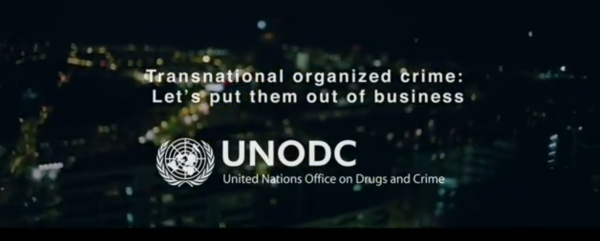UNODCs World drug report og Count the costs

UNODC: Hvert år genererer grenseoverskridende organisert kriminalitet anslagsvis 870 milliarder dollar, truer fred og menneskers sikkerhet, fører til at menneskerettigheter blir brutt og undergraver økonomisk, sosial, kulturell og politisk utvikling i samfunn rundt om i verden.
Krigen mot narkotika mater dessuten HIV-/AIDS-epedemien.
UNODC
United Nations Office On Drugs and Crime UNODC har lansert en ny kampanje: Transnational organized crime – Let’s put them out of business.
«The campaign is being rolled-out through online channels and international broadcasters with an aim to raise awareness of the economic costs and human impact of this threat. By dealing with issues such as human trafficking, the smuggling of migrants, counterfeiting, illicit drugs, environmental crime and illegal arms, it offers an insight into today’s core criminal areas.»
«With an estimated value of US$ 320 billion a year, drug trafficking is the most lucrative form of business for criminals.»
World Drug Report
Illicit drug markets have global dimensions and require coordinated responses on a comparable scale. In this context, the World Drug Report aims to improve understanding of the illicit drug problem and contribute to more international cooperation for countering it.

Alternativ rapport
The Alternative World Drug Report: Counting the Costs of the war on drugs
After over 50 years, the current enforcement-led international drug control system is coming under unparalleled scrutiny over its failure to deliver the promised “drug-free world”, and for what the UN Office on Drugs and Crime (UNODC) describes as its negative “unintended consequences” on health, crime, development and human rights.
It is unacceptable that despite acknowledging these negative impacts, neither the UN nor its member governments have meaningfully assessed them to establish whether they outweigh the intended consequences. They are not included in the UNODC’s flagship annual World Drug Report, and are not informing the high-level drug policy debate.
This Alternative World Drug Report fills this gap in government and UN evaluations by detailing the full range of negative impacts of the “war on drugs”, and lays out the options for alternative approaches that could deliver better outcomes.
The Count the Costs initiative is a group of over 100 NGOs from across the globe that are calling on governments and the UN to count the costs of the war on drugs, and explore the alternatives based on the best possible evidence.
United Nations Office On Drugs and Crime (UNODC) meldte i 2005 at markedsverdien for cannabis var på over 140 milliarder kroner. “The cannabis trade, valued at over US$140 bn per year (retail level). There are two distinctly different cannabis markets: herbal cannabis, valued at US$113 bn and cannabis resin, valued at US$28 bn.”
Det ble estimert at det i 2003 var 161 millioner mennesker i verden som hadde brukt cannabis det året. “An estimated 161 million people used cannabis in 2003, between the ages 15 and 64.” https://www.unodc.org/pdf/WDR_2005/volume_1_web.pdf
I 2010 ble det estimert at det var 170 millioner mennesker som hadde brukt cannabis det året. “Some 170 million people consumed the substance at least once a year in the recent period. This is equivalent to some 3.8 per cent of the world’s adult population.”
I 2013-rapporten var estimatet på over 180 millioner mennesker. “There was a minor increase in the prevalence of cannabis users (180.6 million or 3.9 per cent of the population aged 15-64) as compared with previous estimates in 2009.”
I 2014-rapporten så har de valgt å legge inn et «slingringsmonn» på 100 millioner brukere: «In 2012, between 125 million and 227 million people were estimated to have used cannabis, corresponding to between 2.7 and 4.9 per cent of the population aged 15-64 years.»
Et estimat fra 2009 sier at det ble produsert opp mot 77 000 tonn cannabis det året og i de påfølgende år. “It was estimated that the global production of cannabis herb ranged from 13,300 to 66,100 tons and the production of cannabis resin from 2,200 to 9,900 tons.”
Alt dette går inn i den illegale økonomien, år etter år.
UNODC 2012: «With an estimated value of US$ 320 billion a year, drug trafficking is the most lucrative form of business for criminals.”
Se også: «Er det staten eller mafiaen som skal ha kontroll?»
http://luhm.no/?p=4326
Meget interessant sak dette her som etter min mening er alt for lite diskutert. Saken understreker også hvor viktig det er å se helheten og ikke bare prøve å kurere symptomene.
Norsk narkotikapolitikk bidrar til tortur og drap i andre land
FN-programmet for bekjempelse av narkotika og kriminalitet (UNODC) har siden 2005 gitt opptil 22 millioner dollar til støtte for opplæring av Irans antinarkotikastyrker.
Belgia, Frankrike, Irland og Japan har også tidligere bevilget midler gjennom UNODC til et narkotikahundprosjekt. UNODC har også gitt teknisk utstyr for sporing av narkotika til Iran.
Norge, Danmark og Tyskland har forpliktet seg til å yte økonomisk støtte i 2011 og 2014 til et UNODC-program om teknisk samarbeid mot narkotika og kriminalitet i Iran. Dette var oppe på NOAS fagdag «Iran; to år etter valget» i fjor og i følge Tor Kinsarvik, rådgiver Midtøstenseksjonen UD, så var Norges andel på ca 6 millioner.
Under et besøk i juli i 2011 skrøt UNODC-direktøren av Irans arbeid mot narkotika, men han nevnte overhodet ikke de mange dødsdommene for narkotikaforbrytelsene.
John Peder Egenæs, generalsekretær i Amnesty Norge:
«Siden 2005 har Iran blant annet fått over 200 millioner kroner fra FN og EU, nettopp for å bekjempe narkotikakriminalitet. Norge er blant landene som har forpliktet seg til å bidra.»
«Det er veldig bra at norske myndigheter bistår i den internasjonale narkotikabekjempelsen, men her er det er viktig å ha to tanker i hodet på samme tid. Når vi vet at antall henrettete narkotikaforbrytere øker dramatisk, er norske myndigheter seg da bevisst det ansvaret de har ved å bistå iranske myndigheter med narkotikabekjempelse?»
http://anitanyholt.no/samfunn/demonstrasjon-pa-fns-anti-narkotikadag
Lagt til senere, se også:
http://anitanyholt.no/samfunn/ihr